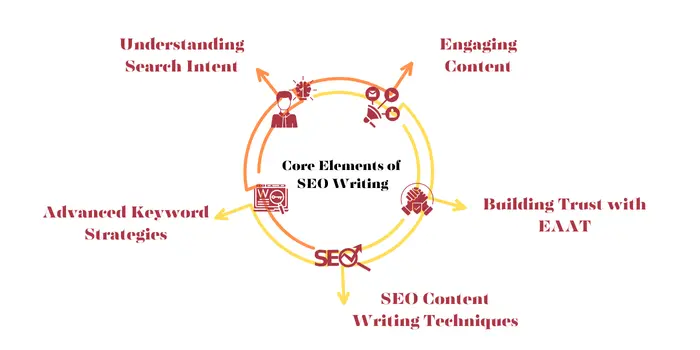

|
Vidya sighed as she looked at her boutique's online store analytics. Despite having the trendiest collection of handmade jewelry in Mumbai and glowing customer reviews, her website was practically invisible online. Last month, she had written beautiful product descriptions, shared stunning photos, and even started a blog about jewelry care. Yet, when she searched "handmade jewelry Mumbai" on Google, her store was buried on page six. "What am I doing wrong?" she wondered, watching as her competitor's websites dominated the first page. The answer wasn't in her products or her content writing quality – it was in how she wrote for the online world. |
SEO content writing is like rolling out a welcome mat for both search engines and your audience. It’s like crafting a detailed map that not only points Google in the right direction but also leads potential customers straight to your digital doorstep.
It’s the difference between a hidden gem tucked away in an unmarked alley and a vibrant store on Main Street, complete with bright signage and a warm invitation to step inside.
Today, success isn’t just about the words you choose – it’s about writing in a way that connects with readers while ensuring search engines can easily find and showcase your content. SEO content writing strikes that perfect balance, transforming simple text into a strategic tool that drives growth and visibility.
Let’s explore how this approach can amplify your business’ online presence and make it easier for your audience to find you exactly when they need what you offer.
SEO content writing is where creativity meets strategy, fueled by the power of data and insights. Unlike traditional content writing, which focuses solely on crafting engaging stories or informative articles, SEO content writing answers three questions:
|
Think about it this way: an article about “best winter coats” might catch someone's eye, but it’s like casting a wide net in a vast ocean. On the other hand, a blog post titled "Top 10 Winter Coats for Extreme Cold in 2024" does more than attract attention. It targets people who are actively searching for specific solutions, often ready to make a purchase. This precision is what makes SEO content writing a game-changer for businesses. |
For any brand looking to create its space online, SEO content writing isn’t just about being found—it’s about being found by the right audience, at the right time, with the right message. It transforms your content from mere words on a screen into a dynamic tool that drives traffic, builds trust, and converts visitors into loyal customers. That’s the unique edge SEO content writing brings to the table.
|
SEO Content Writing doesn’t just tell a story; it ensures the right people hear it. - LexiConn Content |
Modern SEO is all about context and relevance. It’s not enough to sprinkle keywords throughout your content anymore. Search engines like Google now prioritize understanding the bigger picture. Algorithms like Google's Hummingbird and BERT prioritize understanding search intent and semantic relationships between words.
By focusing on search intent and the connections between topics, your content can be more relatable to the audience and rank higher.
Every online search has a purpose. Whether someone is gathering information, looking for a specific website, or ready to make a purchase. The key is to create content that aligns with these intentions. By matching your posts to what your audience wants at that moment, you’re not just improving your search rankings—you’re building trust and guiding them toward action.
The best SEO content engages. Whether it’s through user-generated reviews, AI-driven insights, or personalized recommendations, dynamic content keeps readers hooked. This approach not only makes your site more interactive but also shows search engines that your business is delivering value in unique ways.
Today, simply being present online isn’t enough. Businesses need to ensure their content works hard to attract, engage, and convert their target audience. SEO content writing is the key to making this happen.
Here’s how it works and why it matters for your business.

Every search query represents a specific purpose. Whether people are seeking information, comparing options, or ready to make a purchase, understanding this intent is crucial to crafting content that relates and ranks.
Using tools like Google Keyword Planner, or Moz can help identify user intent. It will also help your business improve visibility and engagement.
Effective keyword strategies go beyond the surface. It delves into advanced practices that make your content both competitive and relevant.
Avoiding Keyword Cannibalization
When multiple pages on your site compete for the same keyword, search engines struggle to prioritize, which can hurt rankings. If multiple pages on your website target the keyword “best mutual funds for beginners,” it can confuse search engines, making it harder for them to determine which page to rank.
Instead, consolidating this information into a single, detailed post ensures your content is focused, strengthens your authority on the topic, and improves your chances of ranking higher in search results.
Content that’s easy to read and navigate doesn’t just keep users on your page longer—it sends positive signals to search engines too.
Internal linking not only improves user experience but also boosts search rankings and website optimization by showcasing the depth of your content.
Google’s algorithm prioritizes content that reflects Expertise, Authoritativeness, and Trustworthiness (E-E-A-T)—a must for sectors like finance, healthcare, and technology, where credibility is non-negotiable.
Here’s how you can establish E-E-A-T:
In industries like edtech, for example, a blog about “Top Online Coding Courses for Beginners” should link to credible certification providers, feature success stories, and be reviewed by experts in education technology.
SEO content writing is about connecting with the right audience at the right time. By understanding search intent, using advanced keyword strategies, crafting user-friendly content, and building trust, your business can stand out in even the most competitive markets.
Whether you’re in edtech, sustainable fashion, EVs, or fintech, SEO content writing can transform your online presence, drive traffic, and help your audience find exactly what they need—when they need it.
If you’re looking to enhance your digital presence, advanced SEO techniques can transform your website. Your website can become a resource that ranks well on search engines and provides genuine value to your audience. Let’s explore strategies that can make your content stand out while relating with both search engines and users.
Gone are the days of standalone posts dominating search rankings. Modern SEO thrives on topic clusters, which involve creating a central “pillar page” supported by in-depth articles that delve into specific subtopics.
This hub-and-spoke approach organizes content cohesively, enabling search engines to understand your site's structure while offering users an intuitive way to navigate.
|
The "hub-and-spoke approach" is a content strategy where a central piece of content (the hub or pillar page) covers a broad topic in-depth, while related, more specific articles (the spokes or cluster pages) dig into subtopics and link back to the main page. |
Imagine your content as a well-organized library. The pillar page acts as the central directory, covering a broad topic like "Financial Planning for Startups." It provides a comprehensive overview and serves as the anchor for related, more focused articles.
For instance, the cluster pages might dive into subtopics such as "Tax Planning Tips for Startups" or "Building an Effective Startup Budget." These pieces not only expand on the main topic but also link back to the pillar page, creating a seamless flow of information.
This structure enhances your site's clarity for both users and search engines. Search engines can better understand the relationships between your content, improving your ranking potential. For users, it offers an intuitive experience, encouraging them to explore more and stay engaged. Over time, this strategy positions your site as an authority on the subject, building trust and driving results.
Example:
A technology company offering cloud solutions could create:
Featured snippets are the highlighted answer boxes at the top of search results. Securing a snippet can position your business as an authority, capturing attention even before users scroll down.
Example:
If targeting “Top CRM Tools for Small Businesses,” include:
This approach not only captures snippet space but also boosts credibility and drives traffic.
Incorporating multimedia elements can significantly improve user engagement and search rankings. Content that holds visitors' attention for longer is rewarded by search engines.
Example:
A fitness brand targeting “Best Workouts for Beginners” could include:
With the rise of Alexa, Siri, and Google Assistant, voice search is shaping how users find information online. Businesses must adapt by optimizing for conversational, long-tail queries.
Example:
Instead of targeting “cloud storage for startups,” optimize for “What’s the best cloud storage solution for small businesses in India?”
AI tools like Jasper and Copy.ai are changing how businesses approach content creation. These tools can speed up tasks such as generating ideas, drafting outlines, and even enhancing existing content.
While AI can streamline processes, human oversight ensures that content remains authentic, engaging, and aligned with your brand’s tone and messaging.
Even with advanced techniques, businesses often face roadblocks in SEO content writing. Here’s how to tackle them:
Excessive keyword stuffing makes content unnatural and risks search engine penalties. Prioritize seamless integration of keywords without compromising readability.
With frequent updates like Google’s Helpful Content Update, quality content has become a top priority. Focus on providing genuine value that aligns with user intent.
Avoid competing with yourself by having multiple pages targeting the same keyword. Instead, consolidate content into one comprehensive resource, ensuring search engines prioritize the most relevant page.
At LexiConn, a specialized SEO content writing agency in Mumbai, we help businesses achieve just that. Whether it’s climbing Google rankings, engaging your audience, or delivering a consistent brand message, we create content that drives measurable results.
When Amazon Business needed to strengthen its online visibility, we delivered a targeted blogging strategy that boosted their SERP rankings and engaged their audience effectively. Want to see how we did it? Read our case study here.
We’re not just another content writing agency—we’re your partners in growth. Based in Mumbai, we combine a deep understanding of local markets with global content standards. What does this mean for your business?
Our team crafts content that doesn’t just work—it works for you. Whether you need website optimization, authoritative blogs, or engaging social media posts, LexiConn is here to help. Let’s create content that grows your business.
📩 Contact us today: [email protected]
🌐 Visit our website: www.lexiconn.in
Your content deserves expertise. Your business deserves LexiConn.



I have read and accept the Privacy Policy
Read More